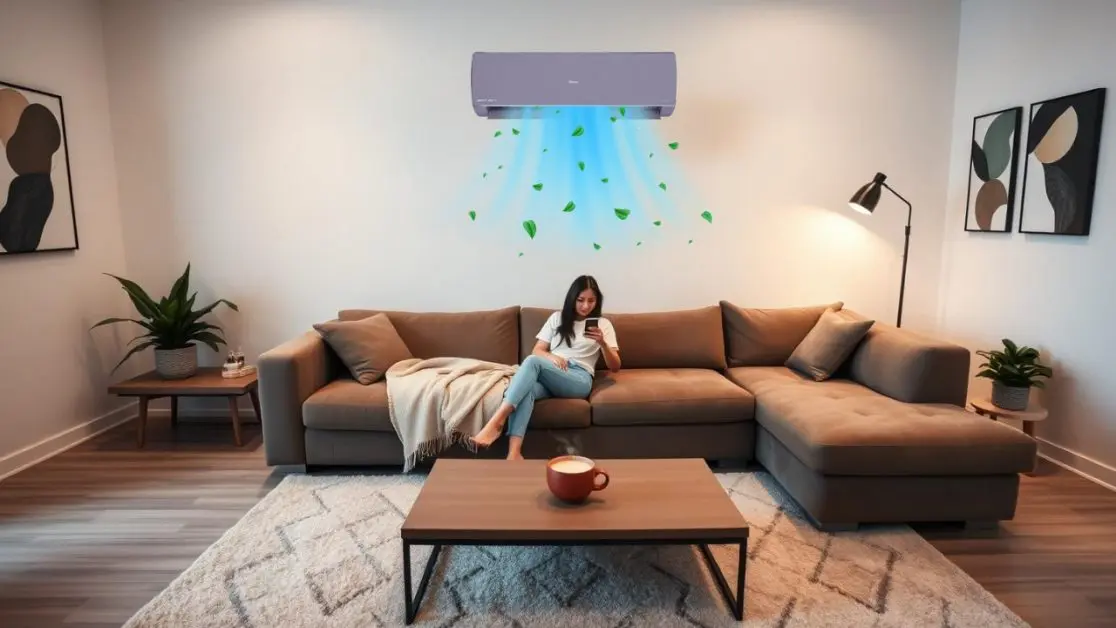Equipment that cools indoor space are Air Conditioners. These are used by people all across India. People have started using air conditioners for humid summer evenings in Kolkata and dry heat in Jaipur. While ACs have their advantages, they also raise the age old question: “AC se bimaar toh nahi pad jaayega?”
To remove any misconceptions, it is worth nothing that today’s air conditioners aren’t what they used to be five or ten years ago. If you’re still stuck with old-school cooling or clinging to outdated beliefs, you might be blaming your AC for problems it didn’t even cause. Worst, you’re not taking advantage of the new tech which was designed in light of Indian conditions that specifically aims to improve wellness.
So, can your AC actually make you sick?
We all know the answer is a “no” but in more detail, “only if it’s the wrong type, wrongly used, or simply neglected.”
We cover the misconceptions, tackle the perplexing questions, and explain how the latest air conditioning units are smarter and can actually safeguard your health.
Myth #1: Sleeping in AC gives you cold and sore throat

What actually happens:
Not exactly cold air can make your throat tender, but does not cause illness. Illness is caused by bacteria. Yes, if your AC is blowing stale, recycled air full of bacteria and dust, it can trigger allergies and throat irritation.
But this is where it gets really interesting. Modern air conditioning splits units act as air filters to the level of a professional-grade purifier.
For example the Super Micro Anti-Bacterial Filter is a mesh filter on steroids. Rather than just sit at the corners of the intake panel like regular filters do, these types of filters at full intake cover and preemptively collect all the dust, allergens and spores floating around so that they don’t end up in your lungs.
Do you feel extra sensitive to smog, pollution or airborne pollen? Some ACs come with smart sensors that provide HEPA level purification. They constantly monitor the air quality inside your home, display smog levels in real-time, check for pollution and tailor purification accordingly.
Rather than worrying about sore throats, you’re far more likely to breathe air that has far less pollutants compared to the outdoors.
Myth #2: ACs make the room too dry and irritate your skin
What really causes that “tight skin” feeling?
That “tight skin” feeling is most likely from overcooling or inefficient compressor operation. Your air conditioner may blow freezing air one minute and then go quiet the next. That cycle of hot and cold creates problems with humidity levels.
But today’s smart inverter systems have fixed that issue.
Newer models can employ PID Inverter Control, which tempers the air volume and maintains it to precise bounds throughout the entire space. It will neither be too frigid in one instant, followed by damp warmth the next.
AI Climate Control can also adjust to one’s routines. For instance, if a user prefers to rest at 25 degrees Celsius then relax at 23 degrees Celsius, the AC would adapt accordingly. It would create a profile with no user interaction. This ensures no irritation to the skin and no shock to the skin, no bracing blasts from the AC while passing the bathroom. Just smooth and constant comfort.
Myth #3: Running AC all night isn’t safe for kids or older people

The smarter way to sleep:
Of course, enduring direct cold air circulation towards your face for the entire night will not be favorable, but it is not the air conditioning unit’s fault. It is the setting and its configuration that causes discomfort.
Intelli Sleep Curve is an innovative feature on today’s air conditioners. It allows you to set a temperature schedule for the night instead of waking up freezing at 3 AM. The AC preemptively stages the cooling to align with your circadian rhythm.
Combining that with Whispering Air Mode that reduces noise levels to 25 decibels (quieter than a whisper) provides a seamless sleep experience. This ensures even the most sensitive sleepers and infants won’t be disturbed.
In addition to that, Dark Mode prevents the display from shining like a torch at night.
Myth #4: ACs spread germs and cause allergies
Actually, some ACs now kill germs.
Old air conditioners are a breeding ground for mold and bacteria if they aren’t cleaned regularly. That musty smell you notice after the first few minutes of turning on your AC is not your imagination. It’s your AC saying, “I need a wash.”
Well, this is what’s different now.
One-button Press activated Modern ACs to execute Complete Indoor Wet Wash. From the coil to filter, modern ACs can wash away dust, bacteria, and slime that, if left uncleaned, would be recirculated back into your room, effectively fully bathing your unit.
Some models use UVC Pro Sterilization which uses ultraviolet light within the AC to eradicate up to 99.98% of airborne viruses. Even COVID-19 can be sanitized, as tested and certified by Texcell.
Not a gimmick, but health technology implemented into your air conditioning system.
Myth #5: Long hours = high bills + high health risks

Not anymore.
The common concern for Indian AC users is facing a high electric bill, followed by the worry of “overusing” the AC.
But it’s 2025 now. Energy-saving does not revolve around turning off your devices; it focuses on smarter solutions.
With AI ECO and other smart features, your power usage will automatically be studied, along with your habits, allowing the studied power to lower energy spikes. In-app dashboards show real-time data tracking hourly, daily, weekly, and monthly. If set, the targets can also be set for electricity usage wherein the smart AC will notify when targets close.
Most importantly, there is no decrease in comfort from the cooling aspects. The AI simply optimizes the system to expend less energy while maintaining effortless comfort. Longer run-time of the AC in free mode comes with enhanced control, not compromise.
Myth #6: Indian power conditions damage ACs over time
Only true if your AC isn’t built for India
The fluctuations in voltage, humidity, and dusty environments are part of a typical day in many Indian cities. Basic ACs just aren’t cut out for it.
Hence, while some air conditioning apparatuses have Hyper PCB, which contain layers of protective coatings to deal with dry dust as well as coastal moisture. It also has flame resistance due to FR-4 material and has a smart power module with the capacity to control compressor speeds based on the dry sensing.
In simple words, your AC would not fry because of dips or surges in voltage.
And for people living in Nagpur, Lucknow, or Gurgaon where temperatures can cross forty degrees Celsius in summers, these ACs are operational even at sixty degrees centigrade. Branded as High Ambient Performance, these are not just attractive phrases but crucial components for survival.
Myth #7: ACs don’t cool bigger rooms well

Ever heard of Long Air Flow?
If it is thirty minutes after you switched your air conditioning system and your living room does not feel cooler, then it is probably because the motor and fan of the air conditioning system are not powerful enough.
The latest models include Long Air Flow technology which cools air up to 20 metres, enough for corners and dining areas. Now, cool air circulation is better than just a blast over the sofa.
For unexpected guest arrivals or after a power cut, the Turbo Mode kicks the motor into high gear. Your room will be cooled in under 10 seconds. No more waiting and sweating.
Myth #8: ACs are hard to maintain and cost a fortune in servicing
You won’t need a technician every season anymore
If you’re calling a technician every summer to “clean the AC,” you’re wasting resources.
Modern units have features like Frost Self Clean and Hydrophilic Aluminum fins that get rid of water and dust autonomously. At the press of a button, the unit refrigerates parts and expands them, allowing cold gas to push out dirt and germs residue.
That means around ₹2000 is saved every year on servicing. The AC maintains peak cooling performance because no dust or residue is blocking the functions, and the serviced air is untainted.
Myth #9: ACs look bulky and don’t match modern homes

Not true anymore
As the saying goes, “Out with the old, in with the new.” Smartphones and everything else received an upgrade, and so did ACs. Newer models now come framed in fabric or stone panels, and are less than 18 cm thick. Sleek modern architecture made them easier to blend into urban apartments or sophisticated living rooms.
Some models have a “Universal Outdoor Unit,” which allows connection of wall-mounted, ducted, and cassette indoor units to a single outdoor unit. It saves on space and installation hassle, which is always in demand.
Living in a city where every inch of square footage is precious? This is a huge advantage.
So, how about the common assumption that air conditioning can lead to sickness?
If the air conditioner is outdated, poorly positioned, or not regularly serviced, then yes.
But, with the right equipment: UVC sterilization, anti-bacterial filters, and self-cleaning coils, an air conditioner is more likely to be one of the healthiest devices in the house.
In modern times, ACs have many additional functions besides controlling the temperature indoors. They include monitoring air quality, energy efficiency, sleep comfort, and health security. They are finally designed keeping Indian homes in mind.
Smart Tips and Final Thoughts
Is your current air conditioning system making your throat sore, when your bills sky-high, and sleep is uncomfortable? In that case, an upgrade is due, and this is true from both a feature and peace-of-mind perspective.
Today, some of the latest electric ACs in India come equipped with exactly the tech we discussed, capable of battling pollution, self-cleaning, cost-effective, and above all, ensuring the utmost family wellness.
If you’re thinking about making the switch, I recommend checking out new offerings from Haier India. They seem to have achieved an optimal blend of advanced ergonomic design with precise, intelligence-driven cooling and unlike many competitors, abundant wellness features tailored perfectly for real Indian homes.
Your air conditioning unit literally should be there to assist you in breathing, and not leave you putting pieces together like a perplexing puzzle.

